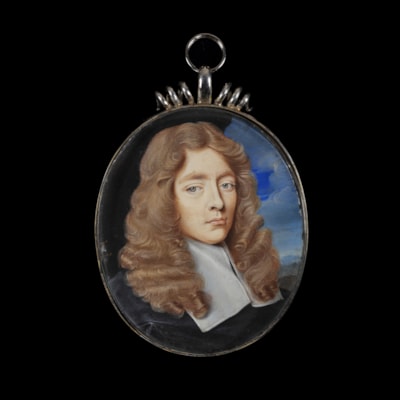DUTCH or ENGLISH SCHOOL
Portrait of a Gentleman, traditionally called Andrew Marvell (1621-1678), wearing a olive green coat with a white lawn chemise and a black sash, pale blue background, his hair worn long
Circa 1650
Oil on metal, silver-gilt frame, the reverse with various collector’s labels[1]
Oval, 51 mm (2 inches) high
SOLD
Although the sitter here must therefore lose his accepted identity, the portrait certainly represents a young man of the Commonwealth period. The lawn collar, the ties terminating in tassels, is typical of the period. The black sash is more unusual, and this combined with his green coat, embroidered with gold thread, suggests that he may have been a man of high office in Cromwell’s Protectorate government. The expensive black sash was a typical adornment for British sitters in the retinue of Walter Strickland (?1598-1671) and Oliver St John (1598-1673) who represented the interests of Cromwell’s government in the Netherlands. As this was a dangerous posting (most of the Dutch supported the Royalists), the salary was high.
The present portrait has clearly been highly prized by collectors of the nineteenth and twentieth century, but is a curious combination of British and Dutch painting techniques and composition. While the technique of oil on metal was practiced by itinerant Dutch artists, the blue background is a nod to the distinctive watercolour miniatures of the sixteenth and seventeenth centuries. It is no surprise that art historians of the past have suggested Mary Beale (1633-1699) as the artist, as the sensitively rendered face is worthy of her hand. However, although Beale was surrounded by miniatures and miniaturists (her son, Charles Beale, painted a watercolour miniature of his mother, now in the collection at Tate Britain), she seems to have focused on oil portraits. It is likely that the portrait was painted by an artist now unknown by name, who received some training from a Dutch master.
Propert, a previous owner of this work, was a highly successful physician who ran a general practise in New Cavendish Street, London. A connoisseur of the arts, he was also a respected amateur etcher and painter, exhibiting at the Royal Academy between 1870 and 1882.
[1] The reverse of the miniature shows the initials ‘JV’, which stands for the collector Jacob H.A E. Visser, Hilversum (1890-1965), a cloth merchant from Manchester and Hilversum. According to Dr Bodo Hofstetter, who kindly provided this information (private correspondence, March 2024) the miniature travelled widely, including to South America, after the Nazis invaded the Netherlands, but never left the family. Visser seems to have owned other portrait miniatures, including Samuel Cooper’s Portrait of a Gentleman, circa 1665, sold Sotheby’s, London, 4th July, 2019, lot 15 and was a noted collector and connoisseur.
[2] Aubrey, Brief Lives (ed. Clark, 1898), vol. II, p. 53.
Omnes de Nijenrode sale, Nijenrode Castle, 1933, lot 829;
Jacob H.A E. Visser, Hilversum (1890-1965) (see footnote 1);
Sold by the niece of Visser’s second wife in ‘Anonymous sale’, Christie's London, 24 May 2000, lot 115;
An Exceptional Eye – A Private British Collection, Sotheby’s, 14 July 2010, lot 8;
Private Collection, UK.
J.J. Foster, Miniature Painters British and Foreign, 1903, vol.I, p. 123;
J.J. Foster, Samuel Cooper & English Miniature Painters of the XVII Century, 1914-1916, Supplement, p. 5, no. 10
Literatur

shipping notice
Worldwide shipping is included in all prices.
The Limner Company does not accept any responsibility for import duty, this is to be paid by the buyer.
Some stock items contain materials from endangered species which are governed by CITES regulations and will require a permit to export outside of Great Britain. If a certificate of export is required then this will be the responsibility of and paid for by the buyer .
you may also like













